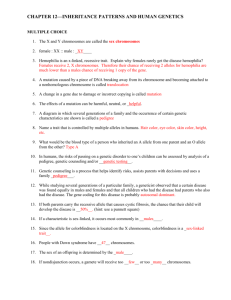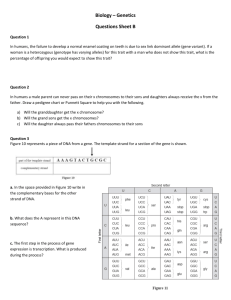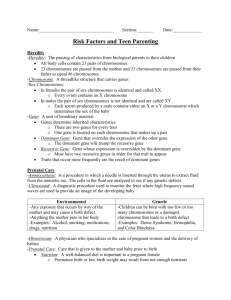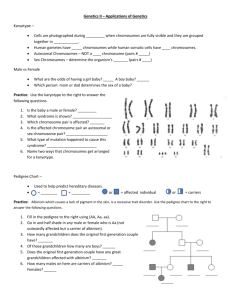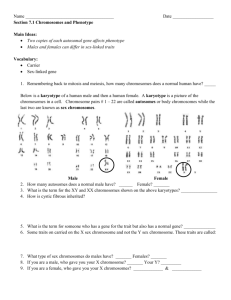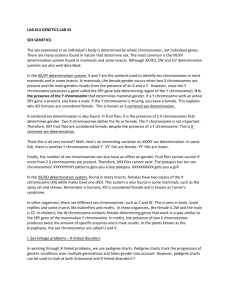LAB #13 GENETICS LAB #2 SEX GENETICS The sex expressed in
advertisement
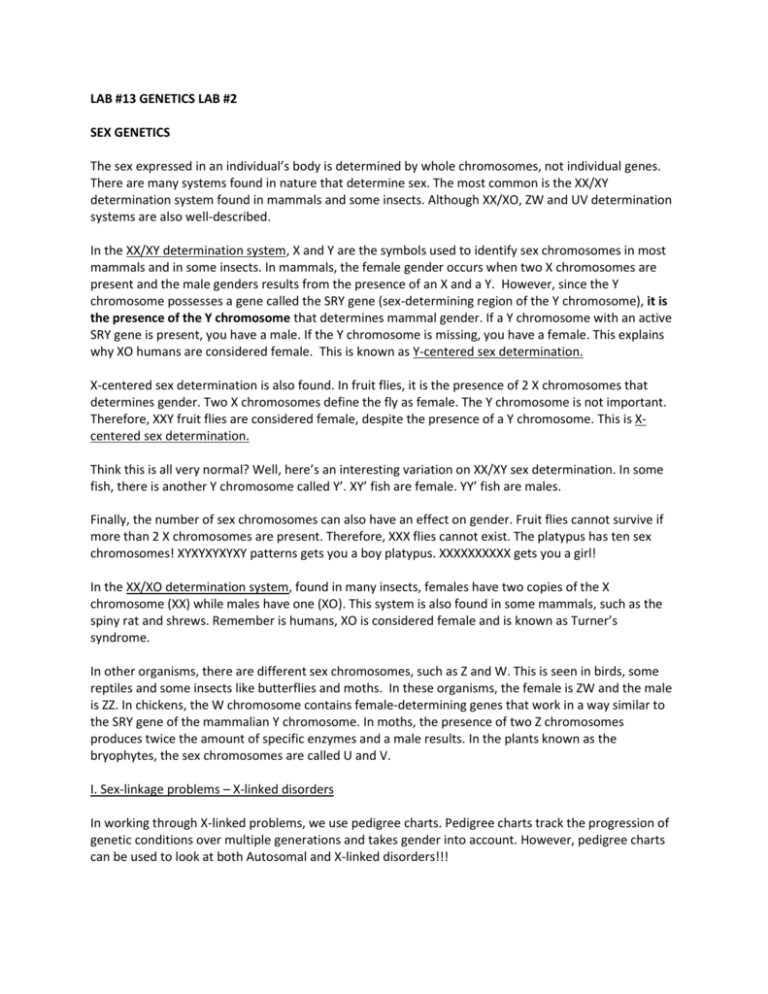
LAB #13 GENETICS LAB #2 SEX GENETICS The sex expressed in an individual’s body is determined by whole chromosomes, not individual genes. There are many systems found in nature that determine sex. The most common is the XX/XY determination system found in mammals and some insects. Although XX/XO, ZW and UV determination systems are also well-described. In the XX/XY determination system, X and Y are the symbols used to identify sex chromosomes in most mammals and in some insects. In mammals, the female gender occurs when two X chromosomes are present and the male genders results from the presence of an X and a Y. However, since the Y chromosome possesses a gene called the SRY gene (sex-determining region of the Y chromosome), it is the presence of the Y chromosome that determines mammal gender. If a Y chromosome with an active SRY gene is present, you have a male. If the Y chromosome is missing, you have a female. This explains why XO humans are considered female. This is known as Y-centered sex determination. X-centered sex determination is also found. In fruit flies, it is the presence of 2 X chromosomes that determines gender. Two X chromosomes define the fly as female. The Y chromosome is not important. Therefore, XXY fruit flies are considered female, despite the presence of a Y chromosome. This is Xcentered sex determination. Think this is all very normal? Well, here’s an interesting variation on XX/XY sex determination. In some fish, there is another Y chromosome called Y’. XY’ fish are female. YY’ fish are males. Finally, the number of sex chromosomes can also have an effect on gender. Fruit flies cannot survive if more than 2 X chromosomes are present. Therefore, XXX flies cannot exist. The platypus has ten sex chromosomes! XYXYXYXYXY patterns gets you a boy platypus. XXXXXXXXXX gets you a girl! In the XX/XO determination system, found in many insects, females have two copies of the X chromosome (XX) while males have one (XO). This system is also found in some mammals, such as the spiny rat and shrews. Remember is humans, XO is considered female and is known as Turner’s syndrome. In other organisms, there are different sex chromosomes, such as Z and W. This is seen in birds, some reptiles and some insects like butterflies and moths. In these organisms, the female is ZW and the male is ZZ. In chickens, the W chromosome contains female-determining genes that work in a way similar to the SRY gene of the mammalian Y chromosome. In moths, the presence of two Z chromosomes produces twice the amount of specific enzymes and a male results. In the plants known as the bryophytes, the sex chromosomes are called U and V. I. Sex-linkage problems – X-linked disorders In working through X-linked problems, we use pedigree charts. Pedigree charts track the progression of genetic conditions over multiple generations and takes gender into account. However, pedigree charts can be used to look at both Autosomal and X-linked disorders!!! In a pedigree chart we use a circle for a female and a square to denote a male. In autosomal disorder, we don’t write out the XX and XY genotypes for each member of the pedigree chart, but simply use the shapes to denote gender. In X-linked disorders, we do write out the genotype and add the letter for the condition as a superscript onto the X (e.g. Xh or XH). Affected individuals have their circle/square colored in. Non-affected individuals have uncolored shapes. Individuals carrying an affected gene, but not showing the phenotype for the condition are referred to as carriers. Here is an example: For Questions 1-9, use the pedigree chart shown below. Some of the labels may be used more than once. ________ 1. A male 2. A female ________ 3. A “marriage” 4. A person who expresses the trait 5. A person who does not express the trait 6. A connection between parents and offspring ________ 7. How many generations are shown on this chart? Assuming the chart above is tracing the autosomal dominant trait of "White Forelock (F)" through the family. F is a tuft of white hair on the forehead. ________8. What is the most likely genotype of individual “A”? (FF, Ff or ff?) ________9. What is the most likely genotype of individual “C”? (FF, Ff or ff?) Complete the following problems in your lab notebook. If necessary, draw a pedigree chart to help you work through these problems 10. In humans, Hemophilia is a blood clotting disorder in which one of the proteins needed to form blood clots is missing or reduced. Individuals have difficulty forming blood clots following injury and may suffer significant blood loss from even minor cuts and bruises. The key clotting factor in hemophilia is called Factor VIII. The gene for Factor VIII is found on the X chromosome. Hemophilia is caused by a lack of Factor VIII and results from a recessive allele (h) found on the X chromosome. The condition for normal blood clotting dominates over non-clotting. A hemophiliac male has a child with a woman who is a carrier for this condition. Using the letter H for normal Factor VIII and h for abnormal Factor VIII, what are the chances that they have a male child who clots normally? 11. In humans, the condition for normal vision dominates color blindness. Both are linked to the X chromosome. Using C for normal vision and c for the color-blind disorder, what are the chances that a color-blind female and color-blind male will have a daughter with normal vision? 12. A normal-visioned male marries a color-blind female. She gives birth to a color-blind daughter. The husband claims the child is not his. Can you support his claim? How? 13. If a color-blind male has a child with a woman who carries one color-blind gene, what are the chances that they have a male child with normal vision? a. 0 b. ¼ c. 1/3 d. 2/3 e. ½ f. ¾ g. 1/1 14. What genotype must each parent have to produce a color-blind daughter? 14. Draw Your Own Pedigree: Hemophilia Remember that because hemophilia is an X-linked disorder, when you identify genotypes in this pedigree, you must use the XX/XY notation and use superscripts with each X chromosome to indicate whether the “H” (normal) or “h” (hemophilia) allele is present. (Ex. XHY = normal male) Hemophilia became known as the “Royal disease” after it suddenly cropped up in some of the descendants of Great Britain’s Queen Victoria and spread through the royal families of Europe. Queen Victoria and her husband Prince Albert had 9 children – 5 girls (Beatrice, Victoria, Alice, Helena, and Louise – none of whom were hemophiliacs) and 4 boys (Edward, Alfred and Arthur had normal blood clotting; their son Leopold, however was a hemophiliac). Beatrice married a man named Henry and they had four children (sons Leopold and Maurice who were hemophiliacs, daughter Eugenie who was not a hemophiliac, and another son who was also not a hemophiliac). Eugenie married Alfonso XIII of Spain (non-hemophiliac) and they had 6 children (2 normal sons, 2 normal daughters and 2 hemophiliac sons). One of those normal sons married a non-hemophiliac woman and gave birth to one son – a nonhemophiliac they named Juan Carlos (the reigning King of Spain). Draw your own pedigree for the Royal family in your lab notebook II. Multiple Alleles For some traits, there are more than two alleles present in the population to form genotypes. These are known a multiple allelic traits. Although the inheritance of multi-allele traits is the same as traits with only two alleles, the number of possible genotypes is greater. Complete the following in your lab notebook. Use a Punnett square to help you determine your answers. 1. In humans, the trait for type A blood and type B blood show incomplete dominance, so that a person with both alleles as blood type AB. Both A and B are dominant over the O allele. Therefore type A blood can have two genotypes: AA and AO. A person with type A blood has a child with a person with type O blood. List the types of offspring they could have and the probability for each blood type. 2. A woman with type O blood gives birth to a baby with type O blood. In a court case, a man with blood type A is named as the father. Could he be the father of this child? Is he the only father or are there other possibilities 3. A woman with blood type B has a child with blood type O. What are the genotypes of the mother and child? Which genotypes could the father NOT have? 4. In radishes, the shape may be long, round or oval. Crosses between long and oval gives 159 oval and 156 long. Crosses between oval and round produce 203 oval and 199 round. Crosses between long and round give 576 oval. Crosses between oval and oval give 121 long, 243 oval and 119 round. Which of the shapes are defined by a homozygous dominant genotype? Homozygous recessive? Heterozygous? III. Gene Interactions Gene interactions are genetic circumstances where two or more nonallelic gene pairs influence the expression of a trait. The common types of gene interactions that exist are: A. Polygenetic inheritance B. Epistasis C. Complementary genes A. Polygenetic inheritance: Polygenetic inheritance is controlled by nonallelic gene pairs, each having an additive effect. A range of phenotypes are possible 1. In some types of wheat, color is caused by two sets of genes. The dominant genes, R and B, are needed for red wheat and has the genotype RRBB. White results when both genes are homozygous and recessive – i.e. rrbb. Any other combination produces brown wheat. A strain with the genotype Rrbb is crossed with a strain of wheat with the genotype rrBb. What is the color of each of the parent strains? Using a Punnet square, what are the possible genotypes and colors that can result from this cross. B. Epistasis: Epistasis is a type of gene inheritance in which two pairs of nonallelic genes determine the expression of a trait and one gene has “veto” power over the other. Animal coat color and human eye are the best examples of epistasis 1. In humans, the allele for brown eyes (B) is dominant over the allele for blue eyes (b). The allele for normal melanin production (M) is dominant over the allele for albinism (m). Give the expected genotypes and phenotypes and their ratios for the children of two individuals who are heterozygous for brown eyes and melanin production (i.e. albinism). C. Complementary genes: Complementary genes are a gene interaction between nonallelic gene pairs. In this case, both gene pairs have veto power over each other 1. In zebra finches, two pairs of nonallelic genes control body color. The dominant alleles of each gene (Q and Z) produce normal body color and the recessive alleles of each pair (q and z) produce albinos. If either homologous pair is homozygous for albinism, the finch is an albino. Do the following crosses and determine the expected genotypic and phenotypic ratios of the possible offspring a. Cross between two normal colored finches who are heterozygous for both genes b. QQzz x qqZZ

